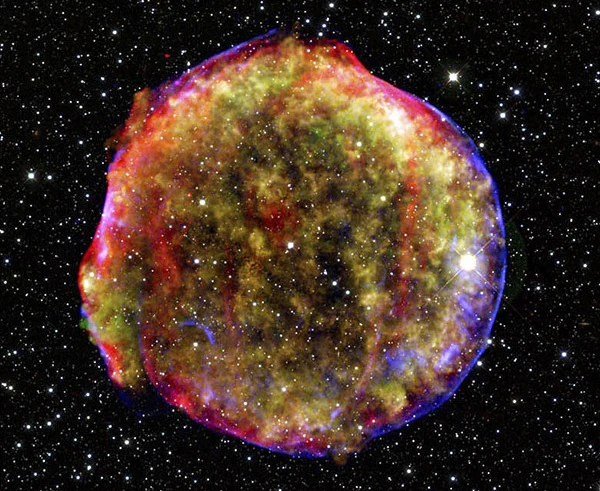
Description of the image: Tycho's Supernova (SN 1572), located 7,500 light-years away, was a nova that appeared in the constellation Cassiopeia in 1572. It was visible to the naked eye on November 11, 1572, brighter than Venus. By March 1574, it had faded below the threshold of visibility. Source Image public domain: composite image of SN 1572 as seen by Chandra X-ray.
A supernova is a massive stellar explosion that marks the end of the life of a massive star. It is a highly energetic and spectacular event where an immense amount of energy is released in a few seconds, causing the supernova to shine as brightly as an entire galaxy for a short period of time.
Supernovae usually occur after the collapse of a massive star's core, often a star several times the mass of the Sun. When the star's nuclear fuel is depleted, the pressure from nuclear fusion reactions is no longer sufficient to counteract the star's gravity, causing the core to collapse.
The resulting compact core can become a neutron star or a black hole, while the star's outer layers are ejected into space at nearly the speed of light, creating a supernova.
There are two main types of supernovae: Type I and Type II.
Super explosions refer to even more extreme events than supernovae, often linked to phenomena such as hypernovae or gamma-ray bursts (GRBs). A hypernova is a particularly powerful supernova, producing energy amounts far greater than a typical supernova.
Gamma-ray bursts, on the other hand, are incredibly intense and brief energy discharges that can exceed the brightness of an entire galaxy for days. They are sometimes linked to the collapse of a very large stellar core that gives birth to a black hole.
In general, a supernova releases an astronomical amount of energy, ranging from 1044 to 1046 joules. This energy is primarily emitted as light and electromagnetic radiation, but it also includes particles and shockwaves that propagate through space. This corresponds to about 10,000 to 100,000 times the energy our Sun emits over its entire lifetime (which lasts about 10 billion years).
A supernova is not an instantaneous event, though it occurs rapidly in astronomical terms. The explosion itself typically lasts from a few days to a few weeks, but the remnants of the explosion (such as the supernova remnant nebula) continue to emit light and energy for months, even years.
Supernovae play a crucial role in the formation of heavy elements. They also contribute to the formation of many isotopes, ions, and other chemical elements. Due to the extremely high temperatures and pressure conditions during these explosions, a wide variety of elements, ionized forms, and isotopes are produced. All elements like gold, lead, and uranium that form in these explosions are scattered into space, enriching the interstellar medium. This contributes to the creation of new stars, planets, and solar systems, and allows the formation of the matter that makes up planets and life.
Although the formation of complex molecules is more common under colder conditions (such as in molecular clouds), supernovae can also trigger the formation of certain molecules in the ejected gases, including simple molecules like carbon monoxide (CO) or carbon dioxide (CO2).